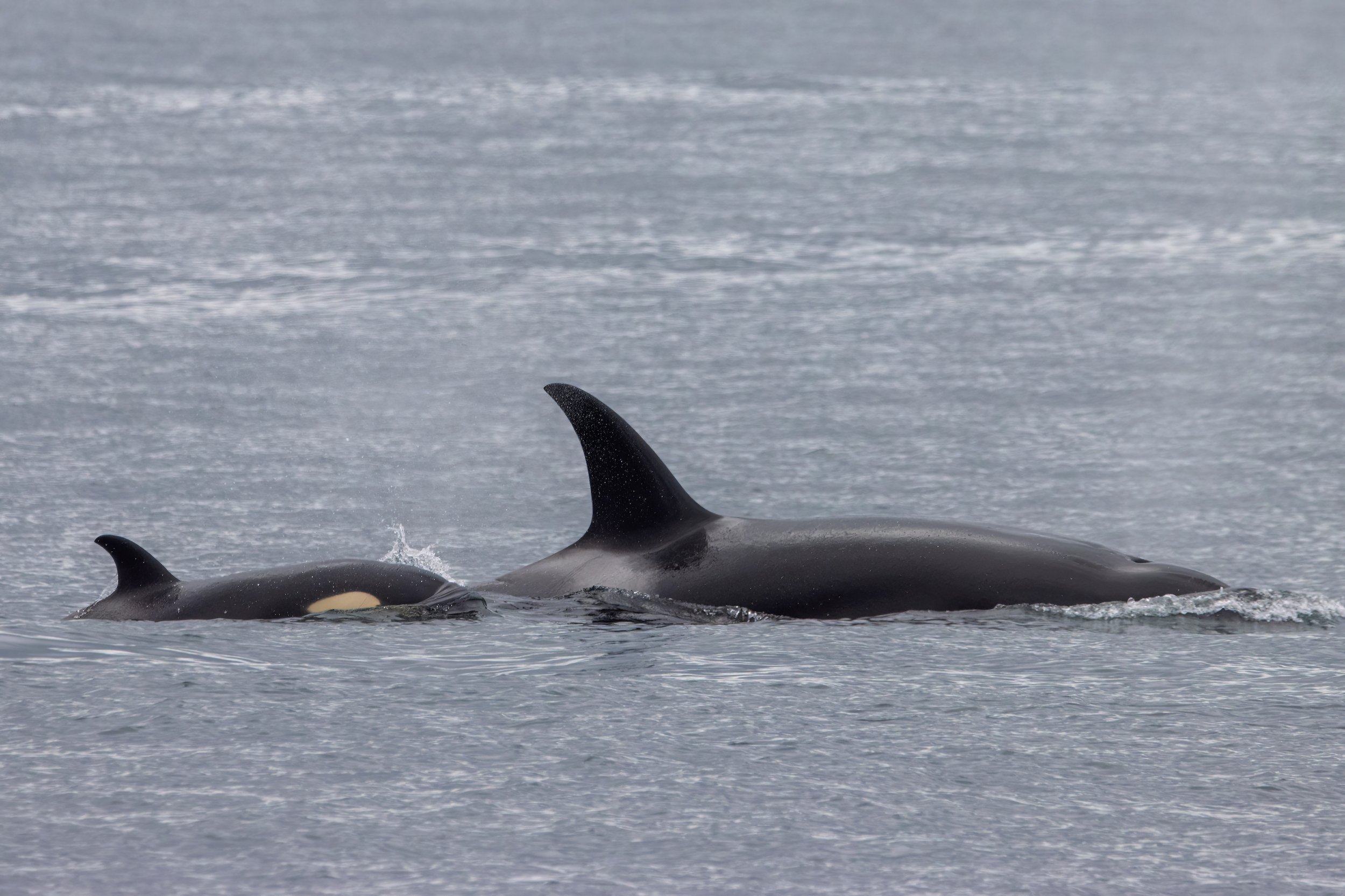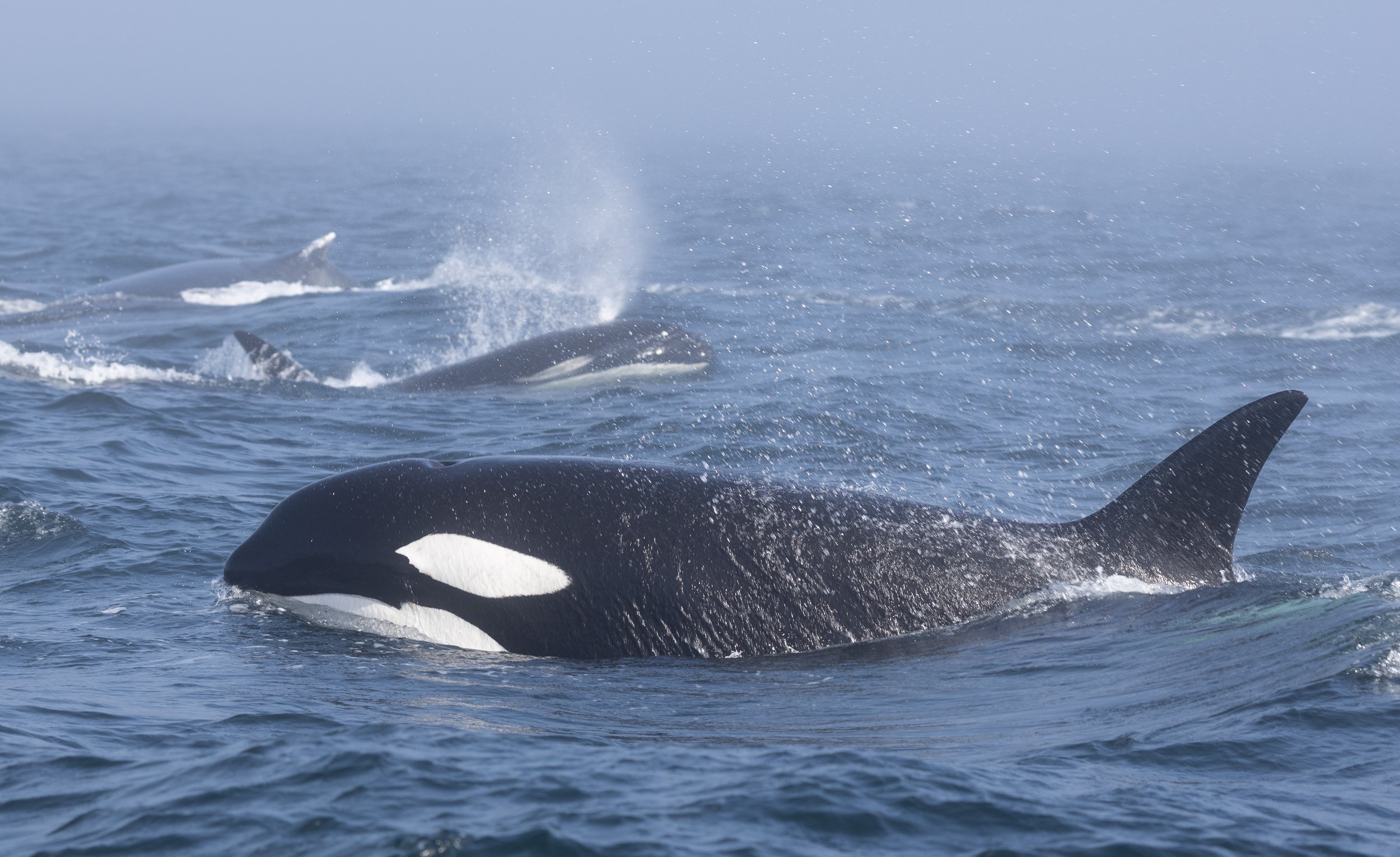
Famed Bigg’s Killer Whale “Chainsaw” Returns; New Calf Spotted with T46B
T063 “Chainsaw” spotted in Salish Sea for first time in 2023. Credit: Sara Hysong-Shimazu, Maya’s Legacy
Famed Bigg’s Killer Whale “Chainsaw” Seen in Salish Sea
Whale Watchers Thrilled by Beloved Orca’s Return; New Calf Also Spotted
SEATTLE, WA & VANCOUVER, BC - April 6, 2023 - The Pacific Whale Watch Association (PWWA) today announced that one of most recognizable members of the coastal Bigg’s killer whale population, T063 “Chainsaw”, has returned to the Salish Sea.
“A Chainsaw sighting is a telltale sign of spring,” says Erin Gless, Executive Director of the PWWA. “He makes an appearance at the same time each year. He’s a local celebrity.”
Chainsaw, named for his distinctive jagged dorsal fin, was first spotted on Tuesday morning in Boundary Pass between the Canadian Gulf Islands and Washington’s San Juan Islands. According to Mark Malleson, a local whale researcher and captain for Prince of Whales Whale Watching, Chainsaw was traveling with his presumed mother, T065 “Whidbey”, and another family, the T049As led by matriarch “Nan”, short for Nanaimo. The whales traveled slowly north along the US/Canada border throughout the day, thrilling whale watch crews and guests alike.
“I finally met the man, the myth, the legend,” said Lauren Tschirhart, marine naturalist for San Juan Safaris in Friday Harbor, Washington. “I’ve known about Chainsaw for years, but always missed out on seeing him. Today was my day. We made sure our guests understood how special this encounter was.”
Born in 1978, Chainsaw is considered one of the oldest males in the Bigg’s population at the age of 45. While Chainsaw’s visits to local inland waters are predictable, they are typically brief, lasting just a few weeks at a time. Beyond the Salish Sea, Chainsaw has been frequently documented throughout southeast Alaska where he is also referred to as “Zorro”.
There are nearly 400 Bigg’s killer whales that feed in the waters of Washington and British Columbia. Unlike endangered Southern Resident killer whales who rely on salmon, Bigg’s killer whales can be seen almost daily in the Salish Sea and are increasing in numbers due to the abundance of seals and sea lions in the area. On Sunday, naturalist Tomis Filipovic of Eagle Wing Tours photographed a new calf traveling with Bigg’s killer whale T046B “Raksha” near Port Angeles, WA. If confirmed by researchers, it will be the 35-year-old whale’s seventh calf.
Chainsaw and other Bigg’s killer whales in the Strait of Georgia. Credit: Sara Hysong-Shimazu, Maya’s Legacy
T063 “Chainsaw”. Credit: Trevor Derie, Outer Island Excursions
New calf with Bigg’s killer whale T046B “Raksha”. Credit: Tomis Filipovic, Eagle Wing Tours
T046B family hunting a sea lion. Credit: Stephen Feng, Prince of Whales
PWWA RELEASES 2022 SIGHTINGS & SENTINEL ACTIONS REPORT
Pacific Whale Watch Association Releases Detailed 2022 Summary Report
PWWA Reports 35,000+ Wildlife Sightings, 1,066 Protective Sentinel Actions in WA & BC
SEATTLE, WA & VICTORIA, BC - March 23, 2023 - The Pacific Whale Watch Association (PWWA) has just released the organization’s 2022 Sightings & Sentinel Actions Report. The 34-page report summarizes data from the PWWA App, a private app used by PWWA captains, naturalists, crew, and affiliates throughout Washington and British Columbia.
Last year, more than 35,000 sightings of whales and other wildlife were reported to the PWWA App by professional whale watchers and authorized contributors. Humpback whales and Bigg’s killer whales were the two whale types most frequently documented by PWWA App users, with humpbacks reported on 310 days and Bigg’s killer whales reported on 293 days. Gray whales were reported on 212 days and minke whales were reported on 166 days. Salmon-eating resident killer whales were documented least frequently, with Southern Resident killer whales reported as being present on 139 days and Northern Resident killer whales reported on 75 days.
In addition to whale sightings, PWWA members documented more than 1,000 “sentinel actions”, in 2022. A sentinel action is a protective action undertaken by professional whale watchers during the course of a tour that benefits whales or other wildlife. Samples of sentinel actions performed by the PWWA in 2022 include:
Stopping other vessels from speeding near whales
Proactively warning vessels of whales nearby
Removing harmful debris from the water
Reporting sick or entangled animals to proper authorities
Of 1,066 sentinel actions documented in 2022, 740 (69%) involved directly contacting other vessels. The PWWA was successful in slowing, stopping, or diverting nearby vessels in the presence of whales in at least 74% of sentinel actions, resulting in quieter and safer conditions. PWWA members were also responsible for retrieving more than 300 pieces of harmful debris, such as balloons, plastic bags, and derelict fishing gear.
The complete PWWA 2022 Sightings & Sentinel Actions Report (16.5 MB) can be accessed here.
2022 Was Record Year for Bigg’s Killer Whales, Humpback Whales, and Protective Sentinel Actions
Bigg’s killer whale mom and calf. Credit: Melisa Pinnow, San Juan Excursions
2022 Was Record Year for Bigg’s Killer Whales, Humpbacks, and Protective Sentinel Actions
Whale Watchers, Researchers Reflect on Bountiful Year of Sightings in Salish Sea
SEATTLE, WA & VICTORIA, BC - January 11, 2023 - 2022 saw record-breaking numbers of Bigg’s killer whales and humpback whales spotted in the waters of British Columbia and Washington state, among continued signs of progress within the Salish Sea ecosystem, according to year-end data compiled by the Pacific Whale Watch Association (PWWA) and local research organizations.
According to the PWWA, which operates year-round whale watching tours in and around the Salish Sea, Bigg’s killer whales and humpback whales were the two types most frequently documented by whale watchers in 2022, reported by PWWA crewmembers on 278 days and 274 days, respectively. Gray whales were reported by the PWWA on 200 days, and minke whales on 158 days of the year. While the salmon-eating Southern Resident killer whale population remains endangered and is rarely encountered by professional whale watchers, Bigg’s killer whales feed on marine mammals, and have been increasing steadily for the past decade.
The Orca Behavior Institute (OBI), which compiles sightings from whale watchers, regional sightings groups, and community scientists, recently announced that there were 1,221 unique sightings of Bigg’s killer whales throughout the Salish Sea in 2022. A unique sighting is a sighting of a specific group of whales on a single day and does not include repeat reports of the same whales on the same day. That number is 154 sightings more than 2021’s record, and double the number of Bigg’s sightings five years ago in 2017. During 2022, the PWWA reported a single-day record with more than 70 Bigg’s killer whales spread in area waters from Hood Canal in Washington to Vancouver Island’s Campbell River region in British Columbia.
According to BC research group Bay Cetology, the coastal Bigg’s population continues to grow, with approximately 370 individuals including 10 new calves welcomed in 2022. Formerly dubbed “transient” killer whales because they were seen infrequently decades ago, their growing presence has prompted the research and whale watching communities to transition toward the new moniker, Bigg’s killer whales, after pioneering killer whale researcher Dr. Michael Bigg.
“When Bigg's were first studied in the Salish Sea, it was just after the implementation of the Marine Mammal Protection Act,” says Monika Wieland Shields, Director of Orca Behavior Institute. “In the decades since, seals, sea lions, and porpoises have all recovered in spectacular fashion. The Salish Sea can now support many more killer whales than it used to, and clearly word has spread.”
Breaching humpback whale BCY0409 “Yogi”. Credit: Sierra Hamilton, Eagle Wing Tours
“HUMPBACK COMEBACK” CONTINUES
While the Salish Sea has long been known for its killer whales, it is fast-becoming recognized as one of the best places to observe humpback whales as well. Researchers with the Canadian Pacific Humpback Collaboration recently announced that 396 individual humpback whales were photographed in the Salish Sea over the course of the 2022 season, the highest number documented in a single year for at least the past century. The figure includes a record-breaking 34 mothers with calves who traveled from their tropical birthing grounds in Hawaii, Mexico, and Central America. According to the PWWA, the previous record of 21 humpback calves was set in 2021. Humpback whales are another Salish Sea success story, growing in number since protective measures prohibiting the commercial hunting of the species were enacted in the 1960’s.
“2022 was a memorable year full of record sightings and dozens of new calves,” says Erin Gless, Executive Director of the PWWA. “20 years ago, it was rare to see humpbacks or Bigg’s killer whales in the Salish Sea. Now, we see them almost every day. It really demonstrates what’s possible if animals have an ample food supply.”
PWWA members collect harmful marine debris. Credit: Jake Hawley, Orca Spirit Adventures.
MORE THAN 1,000 PROTECTIVE ACTIONS IN 2022
In addition to whale sightings, the PWWA also collects data on sentinel actions, or protective interventions performed by professional whale watchers during the course of a wildlife tour. Examples include stopping other vessels from speeding near whales, alerting ferries, cargo ships, or military vessels when whales are nearby, retrieving harmful debris like derelict fishing gear and balloons, and reporting entangled or injured wildlife to proper authorities.
In 2022, PWWA captains, naturalists, and crewmembers documented 1,066 sentinel actions. Of the 740 vessel-related sentinel actions, the PWWA was successful in modifying the behavior of other nearby vessels in 74% of interactions. The association also removed more than 300 pieces of marine debris and reported 20 injured or entangled whales and sea lions to local rescue teams. Additionally, the PWWA provided real-time whale sightings to emergency responders during the recovery of the sunken vessel Aleutian Isle near San Juan Island last summer.
Bigg’s killer whale dorsal fins. Credit: Mollie Naccarato, Sooke Coastal Explorations
Feeding humpback whale. Credit: Clint William, Eagle Wing Tours
Goliaths vs. Goliaths: Orcas, Humpbacks Clash in Tense Encounter
Goliaths vs. Goliaths: Orcas and Humpback Whales Clash in Tense Salish Sea Encounter
VICTORIA, BC & SEATTLE, WA - September 30, 2022 - The Pacific Whale Watch Association (PWWA) witnessed a rare event unfold on Thursday as a large group of Bigg’s (transient) orcas and pair of humpback whales harassed each other during a dramatic hours-long encounter.
The incident began shortly after 11:00 AM near the US/Canada border in the Juan de Fuca Strait, roughly 25 miles (40 km) west of Victoria, BC and Port Angeles, WA. Crew members with Eagle Wing Tours were the first to locate a group of approximately 15 killer whales being unusually active at the surface. Not long afterward, another whale watcher, Captain Jimmy Zakreski of BC Whale Tours discovered likely cause of the orcas’ excitement - two humpback whales in their midst. According to observers who came and went throughout the day, the encounter included an astonishing three hours of breaching, tail-slapping, and loud vocalizations before all of the whales disappeared into the fog, keeping the final outcome of the melee a mystery.
“I’m still trying to wrap my head around it because it was absolutely unbelievable”, says Mollie Cameron, captain and naturalist for Sooke Whale Watching on south Vancouver Island. “At first the orcas seemed to be chasing the humpbacks, but then when it seemed there was space between them, the humpbacks would go back toward the orcas.”
PWWA naturalists identified some of the orcas as the T109A’s, T233, and the T252’s, a group more frequently encountered on the outer coast. The humpback whales involved were identified as BCX1948 “Reaper” and BCY1000 “Hydra”. Reaper is at least 4 years old and has been matched to winter breeding grounds off Jalisco, Mexico. Hydra, an adult female, has been matched to breeding grounds off Maui, Hawaii where she’s given birth to at least three calves in her lifetime.
Bigg’s orcas feed on marine mammals such as seals, sea lions, and porpoises, although they occasionally hunt larger prey like humpback whales. While the PWWA has not documented any fatal orca attacks on humpback whales in the Salish Sea, with the number of both Bigg’s orcas and humpback whales in the region increasing, they believe interactions between the adversaries may become more common.
Whale watchers hope to relocate the two humpback whales involved in Thursday’s encounter before the whales swim south for their annual winter migration. Orcas do not migrate and can be seen at any time of year.
Bigg’s orcas clash with humpback whale “Reaper”. Photo: Mollie Cameron, Sooke Whale Watching, PWWA
Bigg’s orcas surround humpback whale “Hydra”. Photo: Mollie Cameron, Sooke Whale Watching, PWWA
A Bigg’s orca agitates humpback whale “Hydra”. Photo: Mollie Cameron, Sooke Whale Watching, PWWA
Humpback whales BCX1948 “Reaper” and BCY1000 “Hydra”. Photo: Mollie Cameron, Sooke Whale Watching, PWWA
Rare White Orca Sighting Near North Vancouver Island
Rare white orca calf “Frosty” near Telegraph Cove, BC. Photo: Scott Turton, Prince of Whales
Rare White Killer Whale Spotted Near North Vancouver Island
White Orca Calf Named "Frosty" Seen 2,000 KM from California 'Home'
TELEGRAPH COVE, BC - August 11, 2022 - The Pacific Whale Watch Association (PWWA) reported a rare sighting of a white orca in BC waters.
According to PWWA, Scott Turton, a captain for Prince of Whales in Telegraph Cove, was on a tour Wednesday watching Bigg's killer whales when he noticed a nearly all-white animal in the mix. At first Scott thought it might be T46B1B Tl'uk, a white orca known throughout the Salish Sea, but after getting photos, it was clear it was not. Scott recalled another white orca that had been seen several times in California (and even as far south as off Tijuana, Mexico on October 28, 2021) and reached out to researcher Alisa Schulman-Janiger with the California Killer Whale Project.
Schulman-Janiger confirmed that traveling with members of the local T060 and T069 families were CA216C and her white calf, CA216C1 "Frosty". At one point the two California whales branched off on their own and found themselves in very shallow water in Beaver Cove, but by 5:00 PM they had left the cove and were seen by Captain Scott on the Prince of Whales boat heading west, just the two of them, away from the area.
Frosty was first seen as a newborn by Monterey Bay Whale Watch in August 2019, but has never been documented in BC waters, although according to a post from California Killer Whale Project, the mom, CA216C, was seen near Alert Bay in July 2014 with her family.
"The distance between that Mexico sighting in late October 2021 to yesterday's sighting near Telegraph Cove is more than 2,500 km - quite the trip!," said Erin Gless, PWWA executive director. Prior to yesterday, the last sighting of Frosty was off California’s Farallon Islands on June 26 of this year.
Naturalists aren't sure what exactly makes Frosty white, but it's not the first whale that has been seen in this area with a similar condition. Tl'uk is a well-documented young whale who unfortunately hasn't been seen since April 2021. There was also Chimo who was kept at Sealand in the 1970's. It's thought these whales' unusual coloration could be caused by something called Chédiak–Higashi syndrome.
Frosty surfaces near Sointula, BC. Photo: Scott Turton, Prince of Whales


















